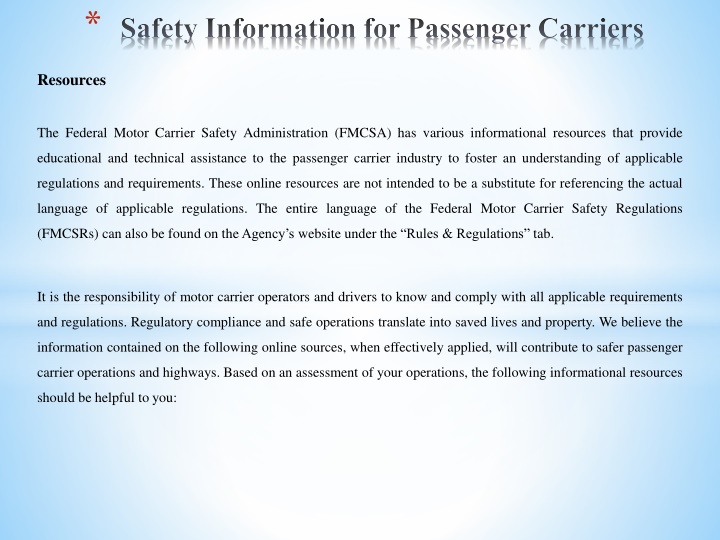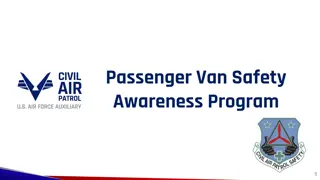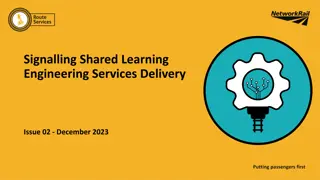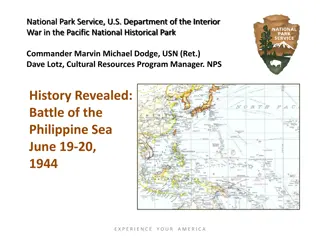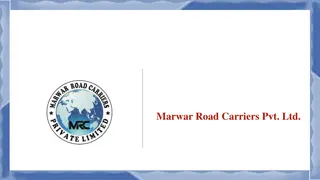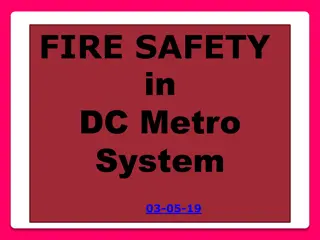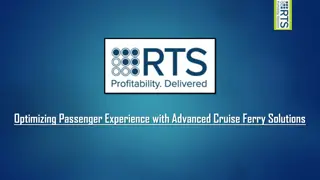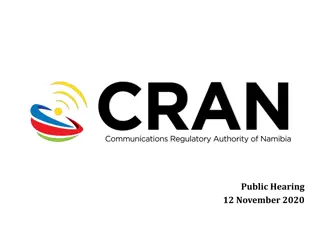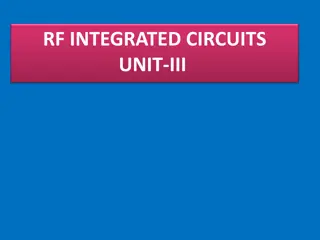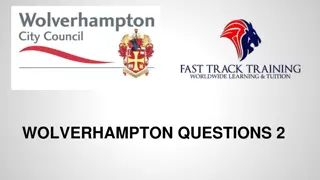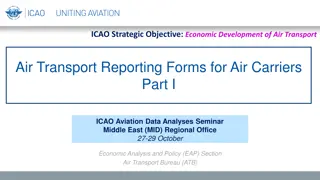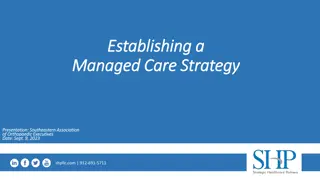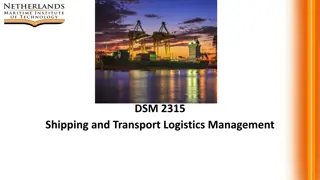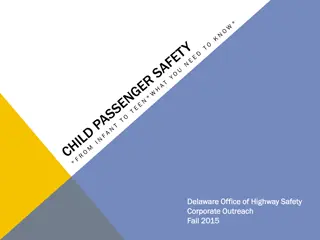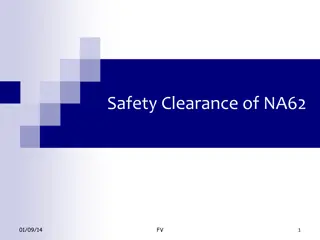Safety Information and Resources for Passenger Carriers
Federal Motor Carrier Safety Administration (FMCSA) provides educational resources for passenger carriers to enhance safety and regulatory compliance. Topics include emergency exits, seat belt use, passenger safety instructions, and presentation methods. Following these resources aids in promoting safe operations and highway travel for passenger carriers.
Download Presentation

Please find below an Image/Link to download the presentation.
The content on the website is provided AS IS for your information and personal use only. It may not be sold, licensed, or shared on other websites without obtaining consent from the author.If you encounter any issues during the download, it is possible that the publisher has removed the file from their server.
You are allowed to download the files provided on this website for personal or commercial use, subject to the condition that they are used lawfully. All files are the property of their respective owners.
The content on the website is provided AS IS for your information and personal use only. It may not be sold, licensed, or shared on other websites without obtaining consent from the author.
E N D
Presentation Transcript
* Safety Information for Passenger Carriers Resources The Federal Motor Carrier Safety Administration (FMCSA) has various informational resources that provide educational and technical assistance to the passenger carrier industry to foster an understanding of applicable regulations and requirements. These online resources are not intended to be a substitute for referencing the actual language of applicable regulations. The entire language of the Federal Motor Carrier Safety Regulations (FMCSRs) can also be found on theAgency s website under the Rules & Regulations tab. It is the responsibility of motor carrier operators and drivers to know and comply with all applicable requirements and regulations. Regulatory compliance and safe operations translate into saved lives and property. We believe the information contained on the following online sources, when effectively applied, will contribute to safer passenger carrier operations and highways. Based on an assessment of your operations, the following informational resources should be helpful to you:
* Passenger Safety Recommended Safety Topics to be Covered Emergency exits - Point out the location of all emergency exits (push-out windows, roof vent, and side door) and explain how to operate them. Emphasize that, whenever feasible, the motorcoach door should be the primary exit choice. Encourage able-bodied passengers to assist any injured or mobility-impaired passengers during an emergency evacuation. Provide passengers with sufficient guidance to ensure compliance with 49 CFR 392.62, "Safe operation, buses." Seat Belt Use - If equipped, recommend the use of shoulder/lap seat belts whenever passengers occupy any seating position. Emergency Contact -Advise passengers to call 911 by cellular telephone in the event of an emergency. Driver Direction -Advise passengers to look to the driver for direction and follow his/her instructions. Fire Extinguisher - Point out the location of the fire extinguisher.
* Passenger Safety Restroom Emergency Push Button or Switch - Inform motorcoach passengers of the emergency signal device in the restroom. Avoiding Slips and Falls - Warn passengers to exercise care when boarding and exiting the motorcoach and to use the handrail when ascending or descending steps. Encourage passengers to remain seated as much as possible while the motorcoach is in motion. If it is necessary to walk while the motorcoach is moving, passengers should always use handrails and supports.
* Passenger Safety Methods of Presenting the Amended Safety Information The following presentation methods are examples of how to present safety information to motorcoach passengers. The list below should not be construed to restrict combinations of the following methods or additional presentation methods. 1. During passenger boarding - Informational pamphlets or printed materials could be distributed to motorcoach passengers during boarding. 2. After passenger boarding and immediately prior to moving the motorcoach The driver requests the passengers to review informational pamphlets/printed materials located in the seat back pocket. The driver provides an oral presentation (similar to the presentations by airline flight attendants prior to take-off) with or without informational pamphlets/printed materials as visual aids. An automated presentation over the motorcoach audio system. An automated presentation over the motorcoach video system.
* Passenger Safety Timing and Frequency of the Presentation Demand-responsive motorcoach operations, such as charters and tour services, should present the safety information to motorcoach passengers after boarding and prior to movement of the motorcoach. Fixed route motorcoach service operations should present the safety information at all major stops or terminals, after any new passengers have boarded and prior to movement of the motorcoach. FMCSA-Updated: Monday, September 26, 2016
* Passenger Safety 374.317 Identification bus and driver. Each bus and driver providing service shall be identified in a manner visible to passengers. The driver may be identified by name or company number.
* Passenger Safety Subpart B Limitation of Smoking on Interstate Passenger Carrier Vehicles 374.201 Prohibition against smoking on interstate passenger-carrying motor vehicles. (a) All motor carriers of passengers subject to 49 U.S.C. subtitle IV, part B, shall prohibit smoking (including the carrying of lit cigars, cigarettes, and pipes) on vehicles transporting passengers in scheduled or special service in interstate commerce. (b) Each carrier shall take such action as is necessary to ensure that smoking by passengers, drivers, and other employees is not permitted in violation of this section. This shall include making appropriate announcements to passengers, the posting of the international no-smoking symbol, and the posting of signs in all vehicles transporting passengers in letters in sharp color contrast to the background, and of such size, shape, and color as to be readily legible. Such signs and symbols shall be kept and maintained in such a manner as to remain legible and shall indicate that smoking is prohibited by Federal regulation. (c) The provisions of paragraph (a) of this section shall not apply to charter operations as defined in 374.503 of this part.
* Commercial Motor Vehicle Marking Eliminates the marking regulations of the former Interstate Commerce Commission. Requires all interstate motor carriers to display the USDOT number. Requires that CMVs be marked with the legal name, or a single trade name, of the business entity that owns or controls the motor carrier operation. This information must match the information on the motor carrier's Form MCS-150 .
* Passenger Safety 374.313 Equipment. (a) Temperature control. A carrier shall maintain a reasonable temperature on each bus (except in commuter service). (b) Restrooms. Each bus (except in commuter service) seating more than 14 passengers (not including the driver) shall have a clean, regularly maintained restroom, free of offensive odor. A bus may be operated without a restroom if it makes reasonable rest stops. (c) Bus servicing. Each bus shall be kept clean, with all required items in good working order.
* Passenger Safety 392.62 Safe operation, buses. No person shall drive a bus and a motor carrier shall not require or permit a person to drive a bus unless (a) All standees on the bus are rearward of the standee line or other means prescribed in 393.90 of this subchapter; (b)All aisle seats in the bus conform to the requirements of 393.91 of this subchapter; and (c) Baggage or freight on the bus is stowed and secured in a manner which assures (1) Unrestricted freedom of movement to the driver and his proper operation of the bus; (2) Unobstructed access to all exits by any occupant of the bus; and (3) Protection of occupants of the bus against injury resulting from the falling or displacement of articles transported in the bus.
* Passenger Safety 392.64 Riding within closed commercial motor vehicles without proper exits. No person shall ride within the closed body of any commercial motor vehicle unless there are means on the inside thereof of obtaining exit. Said means shall be in such condition as to permit ready operation by the occupant
* Passenger Safety 392.71 Radar detectors; use and/or possession. (a) No driver shall use a radar detector in a commercial motor vehicle, or operate a commercial motor vehicle that is equipped with or contains any radar detector. (b) No motor carrier shall require or permit a driver to violate paragraph (a) of this section.
* Passenger Safety Subpart H Limiting the Use of Electronic Devices 392.80 Prohibition against texting. (a) Prohibition. No driver shall engage in texting while driving. (b) Motor carriers. No motor carrier shall allow or require its drivers to engage in texting while driving. (c) Definition. For the purpose of this section only, driving means operating a commercial motor vehicle, with the motor running, including while temporarily stationary because of traffic, a traffic control device, or other momentary delays. Driving does not include operating a commercial motor vehicle with or without the motor running when the driver moved the vehicle to the side of, or off, a highway, as defined in 49 CFR 390.5, and halted in a location where the vehicle can safely remain stationary. (d) Emergency exception. Texting while driving is permissible by drivers of a commercial motor vehicle when necessary to communicate with law enforcement officials or other emergency services. [75 FR 59136, Sept. 27, 2010, as amended at 76 FR 75487, Dec. 2, 2011]
* Passenger Safety 392.82 Using a hand-held mobile telephone. (a)(1) No driver shall use a hand-held mobile telephone while driving a CMV. (2) No motor carrier shall allow or require its drivers to use a hand-held mobile telephone while driving a CMV. (b) Definitions. For the purpose of this section only, driving means operating a commercial motor vehicle on a highway, including while temporarily stationary because of traffic, a traffic control device, or other momentary delays. Driving does not include operating a commercial motor vehicle when the driver has moved the vehicle to the side of, or off, a highway and has halted in a location where the vehicle can safely remain stationary. (c) Emergency exception. Using a hand-held mobile telephone is permissible by drivers of a CMV when necessary to communicate with law enforcement officials or other emergency services. [76 FR 75487, Dec. 2, 2011]
